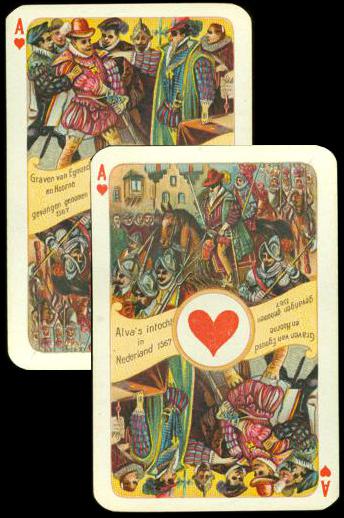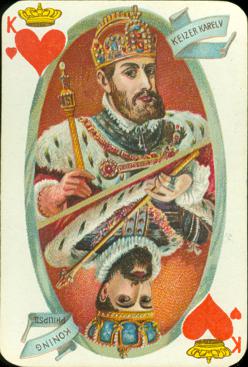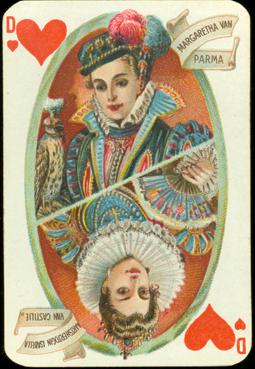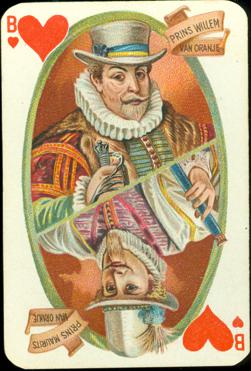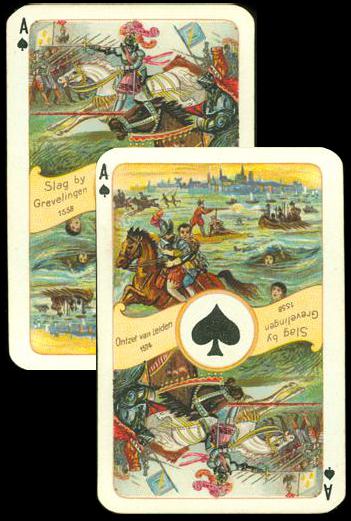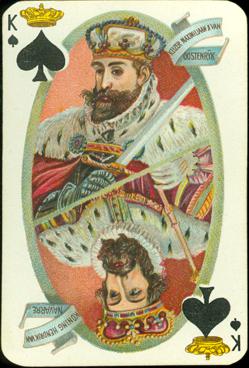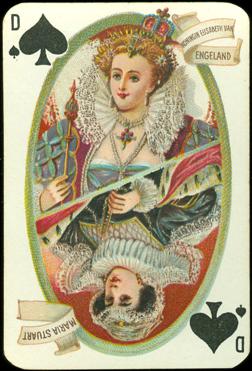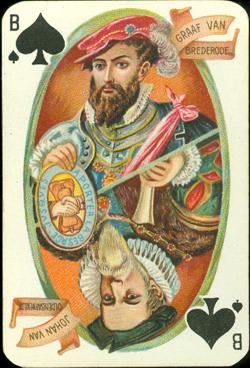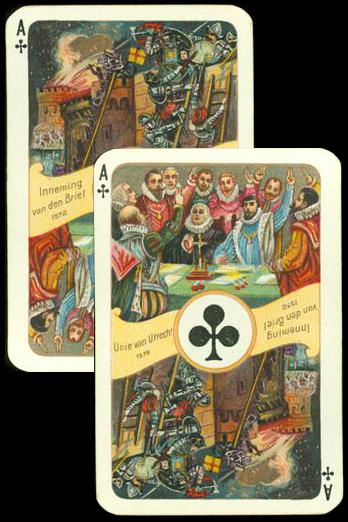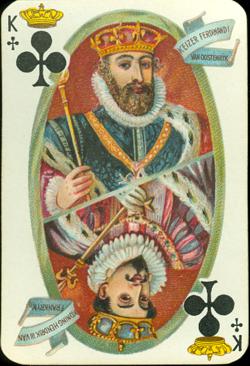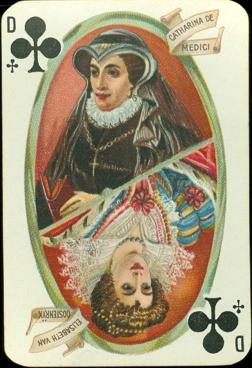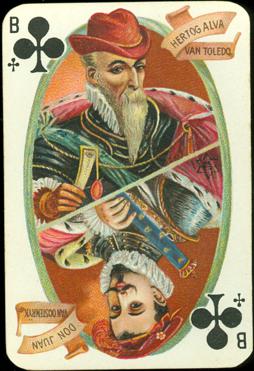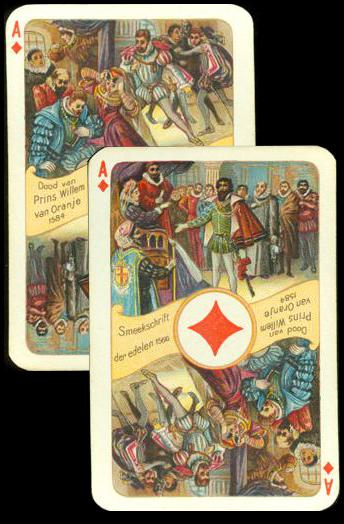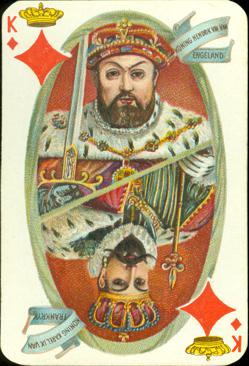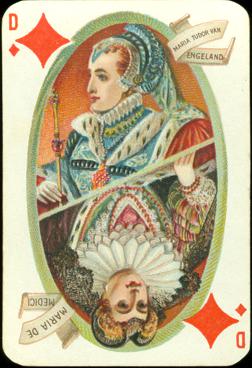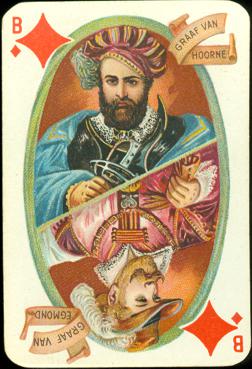December 2013
|
There was only one playing card bourse this month, on
the 8th and we missed it. Miriam wasn't well enough to travel and Joop
still had a chainsaw job to do. A few days before we'd had a severe
storm here and one of our trees had to be topped off or it would have fallen
over.... on the house. It was a beautiful slim
Nordmander tree, about ten meters high, that had served as our Christmas
tree exactly 27 years ago, but now two large pieces of the stem with branches
were on the street and had to be removed.
There were only a few local flea markets, but this month we didn't visit
any of them. So for cards we had to look on the internet again.
Ebay brought us a few nice decks, but again it
|
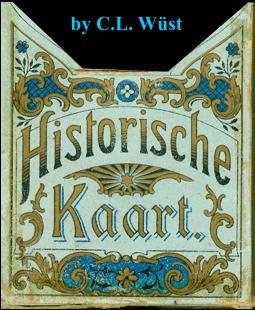
|
was the
Dutch auction site that brought us a rarely seen deck. It caused some discussion
here, when
Joop suggested that we should present it on this spot. This
time it's not a new deck for our collection ánd it's not an obvious improvement
either. That was the condition to earn a spot here. So why is it
here now? Well, we started this xpo in April 2007 and the deck would no
doubt have been shown here if we hadn't already acquired it in 2001. So
from now on we may show an exceptional or rare duplicate deck here, if
that last condition is fulfilled too. We should mention the shortlist,
as there was a nice antique Bongout deck by Frommann & Bunte on it,
a beautiful modern Russian deck and Spanish drawn pin-up deck.
|
|
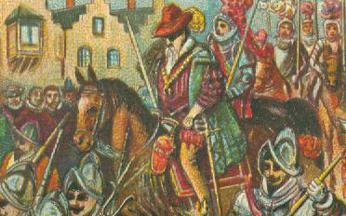 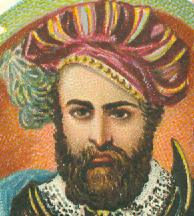 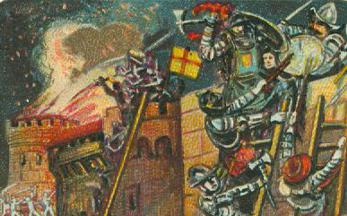 |
But as you see, we
have chosen the "Historische Kaart" (Historical Card) deck, which was
produced by C.L. Wüst for the Dutch market, probably in 1898. It's printed in very
fine chromolithography and the deck was most likely published to commemorate the
250th anniversary of an independent Dutch state, at the end of what the Dutch call their
"Eighty Years War", but what is abroad commonly know as "The
Dutch Revolt". The resurrection of the protestant lower countries in the
north against the Spanish enforced Catholicism lasted from 1568 until 1648 and
resulted in the creation of an independent Dutch Republic, de facto already in 1581 and
de jure in 1648. The deck shows us some important events on the aces and the main
political and military players on the
courts. The indices are officially German, but easy to use for the Dutch too.
The text on the aces and the names on the courts are in Dutch. So..... it's
time for a short history lesson to explain all the depicted events and persons.
Under the
governance of her predecessor, Mary of Hungary, the traditional power had
already for a large part been taken away from the stadtholders of the provinces
and high noblemen. The high nobility had still been appointed in the Council of
State, a governing body of the seventeen provinces that was headed by a
confidant of Philip and advised the governor. In 1564 the noblemen had noticed
unrest among the population as a result of the growing protestant reformation
and they urged for a wise resolution to avoid violence, but Philip II responded
with even harsher measures. Subsequently the counts of Egmond and Hoorne (both
on the Jack of Diamonds) resigned from the Council, together with William of
Orange (see the Jack of Hearts). In 1566 a group of about 400 noblemen presented
a petition ("smeekschrift") to Margaret of Parma, asking to stop
persecutions until rest was restored. It's one of the scenes on the Ace of
Diamonds. During that meeting one of Margaret's courtiers called the petition an
act of beggars ("Geux"in French) and the noblemen took up that name
themselves, "Geuzen". The shield of the Count of Brederode (Jack of
Spades) refers to this ("jusques a porter la besace" = down to carrying
the beggar's wallet").
The aces show events and these are dated. The dates range from 1558 to 1584,
so the first date is before the beginning of the Revolt and the last date
after the de facto independence of the Netherlands. The battle of Gravelingen
(presently Gravelines, in the north of France) in 1558 (on Ace of
Spades) was
important because by the victory of the count of Egmond over the French troops,
the southern border of the low countries was established. On the Ace of Diamonds
one of the scenes shows the death of Prince William of Orange (the "Silent") in 1584. He was the first ruler of the
7 northern provinces, de facto independent since
1881 and his "death" was in fact an assassination by a French roman catholic fanatic.
At the
same time this murder is illustrative for the broader picture of a
religious war between Roman Catholics and Protestants from the
Reformation, of which the main players are also presented in this deck.
On the King of Diamonds Charles IX, since 1560 king of France, is depicted.
The wife of Charles IX was Elisabeth of Austria. She's depicted on the Queen
of Clubs, together with Charles' mother, Catharine de Medici, who is seen as
the instigator of the St. Bartholomew's massacre of 1572, in which throughout
France an estimated 30.000 Huguenots were killed.
On the King of Clubs Emperor
Ferdinand I of the Holy Roman Empire and Henry III, King of France since
1573 are
depicted. Both were Catholics, but once he became king, Henry III was very tolerant towards
the protestants and Huguenots. He was killed by a fanatic roman catholic
monk.
On the King of Spades we find Henry of Navarre, the future Henry IV, who
became King of France in 1589. He was a Huguenot leader and was killed in 1610
by a roman catholic fanatic.
Meanwhile
across the Channel.....
King Henry VIII (see King of Diamonds) had forced a separation
between the Church of
England and the Roman Catholic Church in Rome. His daughter Mary Tudor (see
Queen of Diamonds) became Queen of England in 1553. She got her nickname
"Bloody Mary" for all the persecutions and executions of protestants
and she restored Roman Catholicism in England. After her death her younger
half-sister Elisabeth I became queen of England in 1558 and reversed this
situation. She's depicted on the Queen of Spades, just like Mary Stuart, also
known as Queen of Scots, who had led a rebellion by Catholic noblemen against
Elisabeth I in 1569. Mary was kept in custody for 18 years before being
executed for the attempt to depose of Elisabeth.
|
rebels in
1572. In order to restore the Spanish order there Alva besieged the
town. But the city council had been warned and had stored large supplies
of food and drink. Although the siege was interrupted in March 1574 the
Spanish troops returned again in May of that year. As the council had
not restocked when they could, the town was ready to fall in September.
The rebels broke the dykes and flooded the polder. A favorable wind
caused a rise of the water that drove the Spanish troops away. See the
Ace of Spades. |
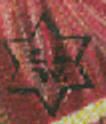
|
The
typical Wüst logo, the star shape with C L W in it, can be found on the Jack of Spades. No mysterious number in this deck though. |
A deed of
abjuration was signed on July 26, 1581 and this can be seen as a declaration
of independence by 17 Dutch provinces and de facto the initiation of a Dutch
Republic. Prince Maurits of Orange was the son of William of Orange (both on
the Jack of Hearts). In 1585 he was appointed stadtholder of Holland and
Zeeland at the age of 18 and 5 years later also of three other provinces. But
he was more active on the battlefield as commander in chief of the Dutch
forces and between 1588 and 1598 he drove the Spanish troops out of the
northern and eastern parts of the Netherlands. The political leadership fell
to John of Oldebarneveld, the attorney general of the young republic. His
portrait is on the Jack of Spades. Although it took a lot more fighting, these
two men paved the way for the official independence, that was agreed on by
Spain and the Netherlands in the Treaty of Munster on January 30, 1648.
So much
for the history lesson.
If you've lost track of all the events and persons involved here, we hope that
at least you've enjoyed the fine portraits and scenes.
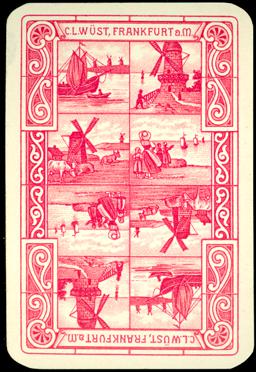
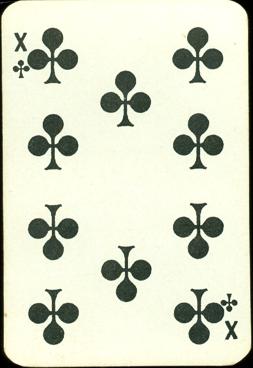
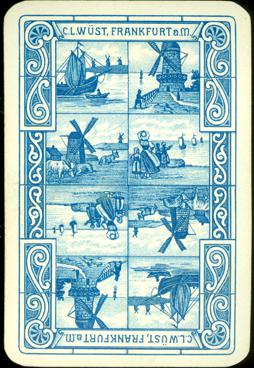
We already had this deck in our collection, with red
backs. The backs of the duplicate deck have the same design
in blue.
All the pips have regular numbers, except for the 10's. They have the roman
number. This feature is not unique and can be found in other Wüst decks.
BACK TO PRESENT MONTH




